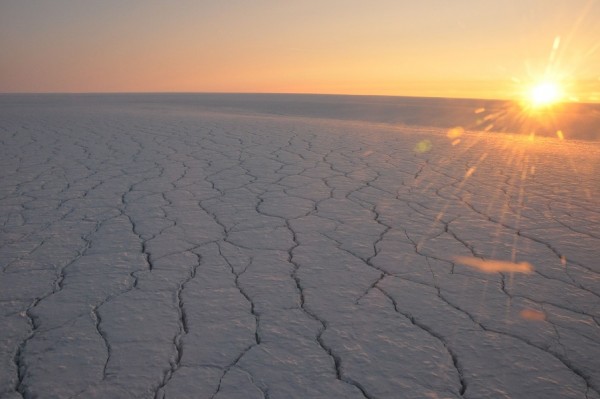By Ana Verayo, | January 13, 2016

Clouds over the Greenland ice sheet raise the temperature, which causes extra meltwater – a third more than clear skies.
Apparently, clouds play a huge role when it comes to the rapidly melting Greenland ice sheet, than first thought. As opposed to clear skies, clouds increase meltwater runoff by one third according to a new study.
Like Us on Facebook
The ice sheet in Greenland is also the second biggest ice mass on the planet where the largest one is Antarctica. However, this ice sheet is losing ice at unprecedented rates, contributing to rising sea levels.
Scientists also note that clouds have not yet been taken into consideration before, especially when it comes to snow loss as ice loss have never been calculated in theoretical climate models. Due to this lack of observations, different models apparently do not yield the same results when clouds are taken as an important factor over the ice sheet.
According to lead author of the study Kristof Van Tricht of University of Leuven in Belgium, clouds have several effects that can add mass to the ice sheet during snowing and on the other hand, they also have an indirect effect on the ice sheet, impacting overall temperature where snow and ice react to this via melting and refreezing.
Van Tricht adds that these work in both ways as clouds can block sunlight and lower temperature and simultaneously, it can also form a blanket, keeping the surface warm during night. In this new study, these two indirect effects on the whole Greenland ice sheet are further examined.
Using specific satellite observations in detecting the clouds over the Greenland ice sheet from 2007 to 2010, researchers compared their results with ground based observations. Upon combining these two observations, they also consolidated this with snow model simulations and climate model data to map out the effect of these clouds.
Researchers discovered that clouds raise the temperature of the entire Greenland ice sheet, triggering additional meltwater runoff of about 56 billion tons every year, which is one third more than clear skies. They also note that contrary to this effect, this melting has not been observable during daytime but more so the next night.
A snowpack is similar to a frozen sponge which releases water during the day but during the night, clear skies cause the meltwater to refreeze inside the sponge. However, when the sky is overcast, temperatures remain high where only some of the water refreezes, resulting in the sponge saturating more quicker as excess meltwater drains off.
This new study urges the need for current climate models to adapt with accurate cloud representations for a clearer estimate of meltwater amount released into global oceans. Researchers also say that this process is crucial for better understanding of climate change, to provide better projections in the future since clouds are now more important than ever in melting ice sheets.
This new study is published in Nature Communications.
-
Use of Coronavirus Pandemic Drones Raises Privacy Concerns: Drones Spread Fear, Local Officials Say

-
Coronavirus Hampers The Delivery Of Lockheed Martin F-35 Stealth Fighters For 2020

-
Instagram Speeds Up Plans to Add Account Memorialization Feature Due to COVID-19 Deaths

-
NASA: Perseverance Plans to Bring 'Mars Rock' to Earth in 2031

-
600 Dead And 3,000 In The Hospital as Iranians Believed Drinking High-Concentrations of Alcohol Can Cure The Coronavirus

-
600 Dead And 3,000 In The Hospital as Iranians Believed Drinking High-Concentrations of Alcohol Can Cure The Coronavirus

-
COVID-19: Doctors, Nurses Use Virtual Reality to Learn New Skills in Treating Coronavirus Patients







